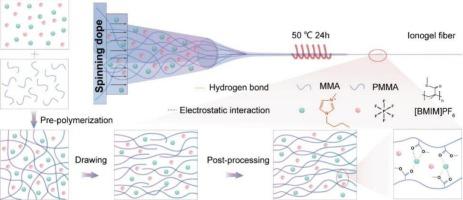玻璃离子凝胶纤维的仿生纺丝,具有可定制的机械性能,可用于多种应用
IF 13.2
1区 工程技术
Q1 ENGINEERING, CHEMICAL
引用次数: 0
摘要
离子导电纤维被认为是有前途的柔性电子软材料;然而,在力学性能方面的不足阻碍了它们的广泛研究和广泛应用。尽管玻璃状聚合物通常具有较高的抗拉强度(10-100 MPa),但在溶剂化和凝胶化过程中保持其优异的机械性能仍然具有挑战性。此外,还缺乏合适的连续纺制玻璃离子凝胶纤维的技术。在此,我们提出了一种仿生纺丝策略,用于直接拉伸具有可设计力学和电学性能的玻璃离子凝胶纤维。离子液体作为增塑剂和溶剂交联剂,在调节预聚合浆料的流变行为和保证连续纺丝的成功方面起着至关重要的作用。ionogel纤维表现出可裁制成衣的抗拉强度(从1.44到61.51 MPa),杨氏模量(从0.64到3.08( MPa GPa),可扩展性(从5.13到541.20 %)和韧性(从1.43到60.27 MJ m−3),连同98 %阻尼能力,卓越的透明度和最佳的离子电导率4.67 × 10−2 年代 m−1。这些纤维可以编织成具有伪装、捕获和感知能力的人工蛛网。此外,作为概念验证演示,离子凝胶纤维通过监测生理信号进一步用于健康控制。我们相信这项工作为方便和可扩展地制造具有调制特性的玻璃离子凝胶纤维开辟了一条可行的途径,可用于多种应用。本文章由计算机程序翻译,如有差异,请以英文原文为准。

Biomimetic spinning of glassy ionogel fibers with tailorable mechanical properties for versatile applications
Ionically conductive fibers are considered promising soft materials for flexible electronics; nevertheless, the insufficiency in mechanical properties prohibits their wide investigations and versatile applications. Although glassy polymers typically possess high tensile strength (10–100 MPa), it remains challenging to preserve their outstanding mechanical properties upon solvation and gelation. Moreover, appropriate technique for continuously spinning glassy ionogel fibers is still lacking. Herein, we propose a biomimetic spinning strategy for directly drawing glassy ionogel fibers with designable mechanical and electrical properties. Ionic liquids play critical roles as plasticizer and solvent cross-linker for regulating the rheological behavior of pre-polymerized dope and guaranteeing the success of continuous fiber spinning. The ionogel fibers exhibit tailorable tensile strength (from 1.44 to 61.51 MPa), Young's modulus (from 0.64 MPa to 3.08 GPa), extensibility (from 5.13 to 541.20 %) and toughness (from 1.43 to 60.27 MJ m−3), together with 98 % damping capacity, excellent transparency and optimal ionic conductivity of 4.67 × 10−2 S m−1. These fibers can be woven to build an artificial cobweb with the capability for camouflage, capture, and sensing. Moreover, as proof-of-concept demonstrations, the ionogel fibers are further used for health control through monitoring physiological signals. We believe that this work opens up a viable route for convenient and scalable fabrication of glassy ionogel fibers with modulated properties for versatile applications.
求助全文
通过发布文献求助,成功后即可免费获取论文全文。
去求助
来源期刊

Chemical Engineering Journal
工程技术-工程:化工
CiteScore
21.70
自引率
9.30%
发文量
6781
审稿时长
2.4 months
期刊介绍:
The Chemical Engineering Journal is an international research journal that invites contributions of original and novel fundamental research. It aims to provide an international platform for presenting original fundamental research, interpretative reviews, and discussions on new developments in chemical engineering. The journal welcomes papers that describe novel theory and its practical application, as well as those that demonstrate the transfer of techniques from other disciplines. It also welcomes reports on carefully conducted experimental work that is soundly interpreted. The main focus of the journal is on original and rigorous research results that have broad significance. The Catalysis section within the Chemical Engineering Journal focuses specifically on Experimental and Theoretical studies in the fields of heterogeneous catalysis, molecular catalysis, and biocatalysis. These studies have industrial impact on various sectors such as chemicals, energy, materials, foods, healthcare, and environmental protection.
 求助内容:
求助内容: 应助结果提醒方式:
应助结果提醒方式:


